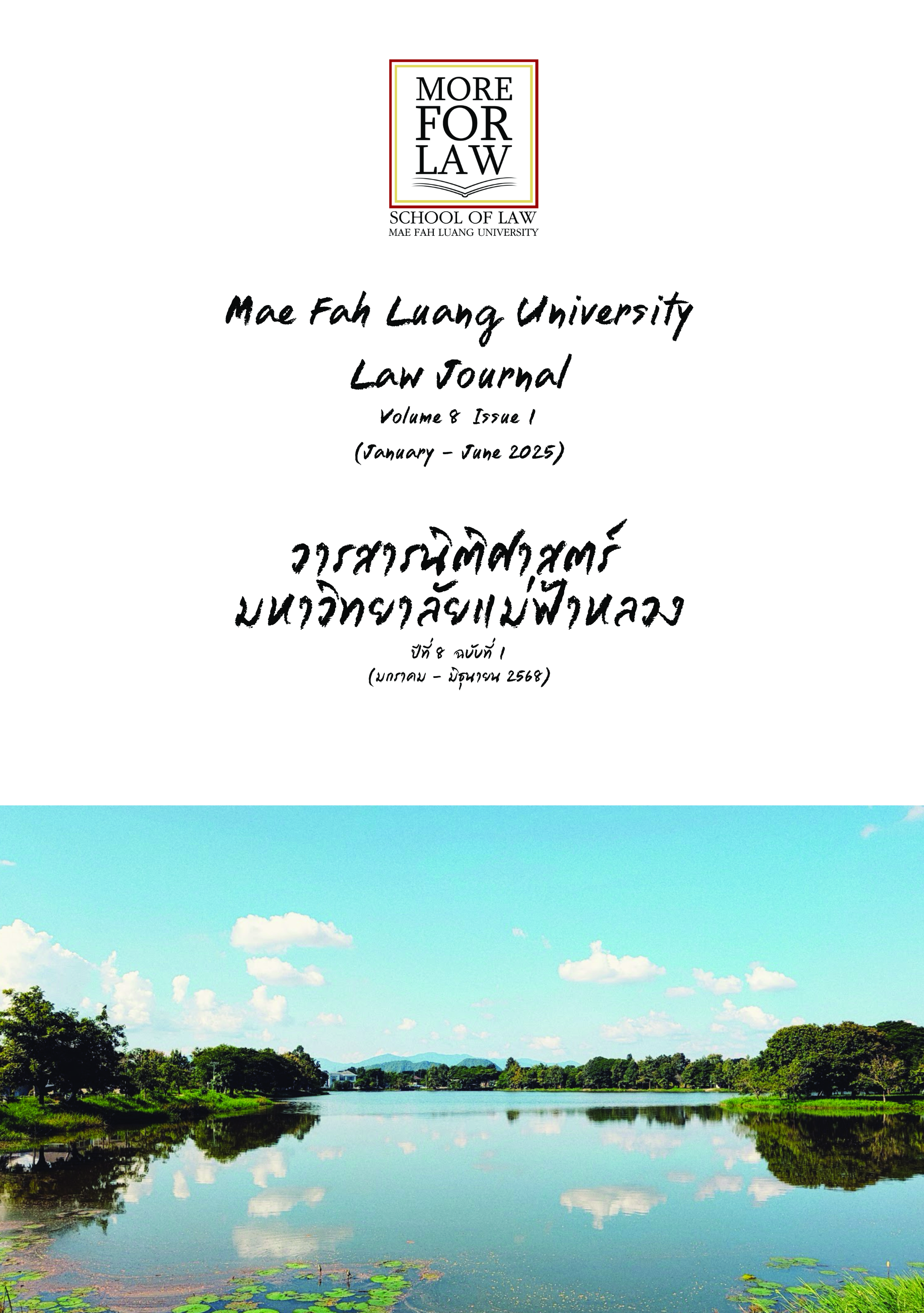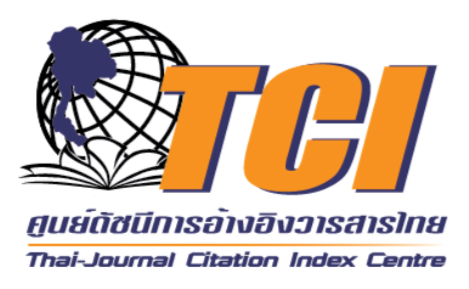Addressing Challenges in Implementing Legal Measures for Controlling and Resolving PM 2.5 In the Upper Northern Region
DOI:
https://doi.org/10.14456/mfulj.2025.4Keywords:
PM 2.5, Air Quality, Environmental Rights, Clean Air LawAbstract
The PM 2.5 pollution crisis in Northern Thailand poses significant health, hygiene, and lifestyle challenges, threatening the well-being and livelihoods of the local population. From December to April each year, the region experiences heightened levels of PM 2.5 due to a combination of forest fires, agricultural burning, and transboundary haze. The geography of Northern Thailand, characterized by high mountains and basin-like plains, exacerbates the problem as particulate matter becomes trapped in the atmosphere, lingering for extended periods. Agricultural burning in neighboring countries is a critical contributor to the transboundary haze issue, often linked to Thai private sector activities supporting cross-border agriculture. Currently, the lack of enforceable legal mechanisms within Thailand hinders efforts to address pollution caused both domestically and internationally. ASEAN member states have signed the ASEAN Agreement on Transboundary Haze Pollution to combat these challenges, a cooperative framework designed to analyze and mitigate the causes and impacts of forest fires and haze. However, the agreement remains non-binding, relying on voluntary compliance and mutual cooperation. This absence of enforceable obligations significantly limits the effectiveness of efforts to address transboundary haze in a tangible and sustainable manner. Stronger legal frameworks and actionable policies are urgently needed to tackle this pressing environmental issue and protect the region's ecosystems and communities.
The PM 2.5 pollution crisis in Northern Thailand represents a significant violation of fundamental human rights, including the right to life and the right to health, as recognized under international and domestic law in many advanced nations. Recently, the United Nations (UN) elevated environmental protection by declaring access to a clean, healthy, and sustainable environment as an international human right, placing it on par with other fundamental rights. However, the Constitution of the Kingdom of Thailand has yet to fully align with these international standards, leaving environmental rights inadequately protected. This gap undermines the safeguarding of individuals’ rights and weakens efforts to address critical environmental issues such as air pollution. A significant obstacle to resolving the PM 2.5 problem lies in the fragmented and outdated legal framework governing air quality. Many current laws were enacted years ago, leading to inefficiencies in addressing contemporary challenges. Air quality standards remain outdated, and specific pollution control regulations targeting major sources are lacking. Furthermore, differing air quality standards set by various responsible agencies create inconsistencies, hindering coordination and integrated action. This disjointed regulatory approach prevents systematic and timely resolution of the PM 2.5 crisis, highlighting the urgent need for comprehensive legal reform, modernized standards, and effective interagency collaboration to protect public health and environmental rights.
The United Nations’ call for accelerated action on environmental protection has prompted countries like the United States and the French Republic to incorporate environmental rights into their constitutions. These initiatives aim to safeguard citizens from environmental threats, including those posed by natural disasters. The Clean Air Act in the United States stands as a landmark framework, effectively addressing air pollution crises and achieving sustained success over decades. Similarly, the French Republic enacted specific environmental laws that were subsequently integrated into its constitution as fundamental rights, underscoring the critical importance of environmental protection at the constitutional level.
In Thailand, increasing awareness of the air pollution crisis among government agencies, the private sector, and the public has led to the proposal of seven drafts of the Clean Air Act. Among these, the Integrated Clean Air Management for Health Act B.E. .... was submitted with the support of 22,000 eligible voters. Studies indicate that this draft law incorporates principles akin to the U.S. Clean Air Act, which has been instrumental in mitigating air pollution.
To address the persistent PM 2.5 pollution problem in Northern Thailand and protect the environmental rights of its citizens, the following recommendations are proposed: Enact a Specific Clean Air Law: A dedicated law should be introduced to address air pollution comprehensively. This legislation should establish an agency specifically tasked with air pollution management, equipped with a task force reporting directly to the prime minister. Such a structure would enable swift decision-making and prompt action. Decentralize Authority: Decision-making power should be devolved from central government to regional and local authorities, particularly in areas with recurring air pollution exceeding health standards. Tailored monitoring and operational plans should be developed for these areas, distinct from general national measures. Amend the Constitution: To align with international standards, Thailand’s Constitution should be amended in Chapter 3: Rights and Freedoms of the Thai People to explicitly recognize the right to live in an environment with clean air that does not harm health. Furthermore, protections should ensure that no individual suffers premature death due to air pollution, with enforceable measures to prevent violations by individuals or government agencies.
These recommendations aim to establish a robust and integrated legal framework, ensuring effective management of air pollution, safeguarding public health, and upholding Thai citizens' environmental rights per global standards.
Downloads
References
กรมควบคุมมลพิษ, ข้อมูลสถิติย้อนหลัง [ออนไลน์], แหล่งที่มา: http://air4thai.pcd.go.th/webV3/#/History
กรมควบคุมมลพิษ, ประกาศดัชนีคุณภาพอากาศของประเทศไทย พ.ศ. 2566 ปรับค่าสารมลพิษเข้มข้นขึ้น ลงประกาศในราชกิจจานุเบกษาแล้ว [ออนไลน์], แหล่งที่มา: https://www.pcd.go.th/pcd_news/30028
กรมควบคุมมลพิษ, มลพิษหมอกควันในพื้นที่ภาคเหนือ: ปัญหาและแนวทาง [ออนไลน์], แหล่งที่มา: https://www.pcd.go.th/wp-content/uploads/2020/06/pcdnew-2020-06-05_07-33-31_040770.pdf
กรมอุตุนิยมวิทยา, การเปลี่ยนแปลงภูมิอากาศ [ออนไลน์], แหล่งที่มา: http://climate.tmd.go.th
กรมอนามัย, คู่มือฉบับประชาชน การเฝ้าระวัง PM 2.5 อย่างไรให้ปลอดภัย, (นนทบุรี: ชุมนุมสหกรณ์การเกษตรแห่งประเทศไทย, 2563).
กรมอุตุนิยมวิทยา, ภาวะเรือนกระจก [ออนไลน์], แหล่งที่มา: http://climate.tmd.go.th
กรรณิกา สินธิพงษ์, เจตนารมณ์และขอบเขตของกฎหมายเกี่ยวกับสิ่งแวดล้อม [ออนไลน์], แหล่งที่มา: https://www.admincourt.go.th/admincourt/editorupload/files/1.pdf
กองประสานการจัดการการเปลี่ยนแปลงสภาพภูมิอากาศ, แผนที่นำทางการลดก๊าซเรือนกระจกของประเทศ ปี พ.ศ. 2564-2573 [ออนไลน์], แหล่งที่มา: https://climate.onep.go.th/th/topic/policy-and-strategy/thailand-ndc-roadmap-on-mitigation/
กฤติยา สุขเพิ่ม, มาตรการทางกฎหมายของการป้องกันและควบคุมมลพิษหมอกควันจากการเผาในที่โล่ง กรณีศึกษา ในพื้นที่ 8 จังหวัดภาคเหนือตอนบน, (วิทยานิพนธ์ปริญญาเอก หลักสูตรนิติศาสตรดุษฎีบัณฑิต คณะนิติศาสตร์ สถาบันบัณฑิตพัฒนบริหารศาสตร์, 2558).
กระทรวงต่างประเทศ, การดำเนินงานตามข้อตกลงอาเซียนเรื่องมลพิษจากหมอกควันข้ามแดน [ออนไลน์],. https://fad.mnre.go.th/th/as/content/255
กระทรวงการต่างประเทศ, ความตกลงปารีส: ก้าวสำคัญของการดำเนินการด้านการเปลี่ยนแปลงสภาพภูมิอากาศ. [ออนไลน์], แหล่งที่มา: https://thai-inter-org.mfa.go.th
กระทรวงทรัพยากรธรรมชาติและสิ่งแวดล้อม,พิธีสารเกียวโต [ออนไลน์], แหล่งที่มา: https://fad.mnre.go.th/th/mph/content/207
กระทรวงทรัพยากรธรรมชาติและสิ่งแวดล้อม, ความตกลงปารีส [ออนไลน์], แหล่งที่มา: https://fad.mnre.go.th/th/mph/content/208
กิตติยาภรณ์ รองเมือง, การประเมินการปลดหล่อยมลพิษจากการเผาไหม้เศษวัสดุเหลือใช้ทางการเกษตรในที่โล่งแจ้ง (วิทยานิพนธ์ปริญญาโท หลักสูตรวิศวกรรมศาสตรมหาบัณฑิต มหาวิทยาลัยเทคโนโลยีสุรนารี, 2558.)
เกรียงไกร เจริญธนาวัฒน์, หลักพื้นฐานกฎหมายมหาชน ว่าด้วยรัฐ รัฐธรรมนูญ และกฎหมาย, พิมพ์ครั้งที่ 11, (กรุงเทพมหานคร: สำนักพิมพ์วิญญูชน, 2564).
คนึงนิจ ศรีบัวเอี่ยม, ความเชื่อมโยงระหว่างสิทธิชุมชนกับทรัพยากรธรรมชาติและสิ่งแวดล้อมภายใต้รัฐธรรมนูญแห่งราชอาณาจักรไทย พุทธศักราช 2560, วารสารรามคำแหง ฉบับนิติศาสตร์, ปีที่ 8 ฉบับที่ 1 (มกราคม-มิถุนายน 2562).
จุฬาลงกรณ์มหาวิทยาลัย, ค่า AQI ดัชนีคุณภาพอากาศ (Air Quality Index) [ออนไลน์], แหล่งที่มา: https://www.eng.chula.ac.th/th/29782
จุฬาลงกรณ์มหาวิทยาลัย, เรียนรู้อยู่กับฝุ่น [ออนไลน์], แหล่งที่มา: https://www.chula.ac.th/wp-content/uploads/2019/10/Chula-PM25.pdf
ทวีศักดิ์ ใจคำสืบ, สถานการณ์หมอกควันในภาคเหนือตอนบน [ออนไลน์], แหล่งที่มา: https://www.tei.or.th/thaicityclimate/public/document-36.pdf
ไทยพับลิก้า, ประเทศไทยถูกจัดให้มีความเสี่ยงด้านภูมิอากาศสูงเป็นอันดับ 9 ของโลก [ออนไลน์], แหล่งที่มา: https://thaipublica.org/2021/04/complex-world-prasart01
นัทมน คงเจริญ, เอกสารประกอบการสอนกฎหมายกับสิ่งแวดล้อม (177452) ปีการศึกษา 1/2561 [ออนไลน์], แหล่งที่มา: https://www.law.cmu.ac.th/law2011/journal/e1559374102.pdf
นฤมล เสกธีระ, ความมีประสิทธิภาพของพระราชบัญญัติส่งเสริมและรักษาคุณภาพสิ่งแวดล้อมแห่งชาติ พ.ศ. 2535 ในการป้องกันและแก้ไขปัญหาสิ่งแวดล้อม, วารสารนิติศาสตร์ มหาวิทยาลัยนเรศวร, ปีที่ 8 ฉบับที่ 1 (พฤษภาคม 2558).
เนตรธิดาร์ บุนนาค, ครบรอบ 50 ปี พ.ร.บ. อากาศสะอาด ปี 1970 ที่สร้างการเปลี่ยนแปลงครั้งใหญ่ในการจัดการปัญหามลพิษทางอากาศของสหรัฐอเมริกา [ออนไลน์], แหล่งที่มา: https://www.sdgmove.com/2021/04/06/50th-anniversary-of-usa-clean-air-act-of-1970/
เนตรธิดาร์ บุนนาค, พลเมืองรัฐนิวยอร์กเห็นชอบแก้ไขรัฐธรรมนูญ ให้ทุกคนมีสิทธิในอากาศและน้ำสะอาด และสิ่งแวดล้อมที่ดีต่อสุขภาพ [ออนไลน์], แหล่งที่มา: https://www.sdgmove.com/2021/11/12/environmental-rights-amendment-pass-in-new-york-constitution/
ประภาภรณ์ โรจน์ศิริรัตน์, มาตรการทางกฎหมายในการเยียวยาผู้ที่ได้รับผลกระทบจากฝุ่นมลพิษ, วารสารนิติศาสตร์และสังคมท้องถิ่น, ปีที่ 5 ฉบับที 1 (มกราคม-มิถุนายน 2564).
ปณิธัศร์ ปทุมวัฒน์, ข้อพิจารณาทั่วไปเกี่ยวกับกฎหมายสิ่งแวดล้อมระหว่างประเทศ, จุลนิติ, ปีที่ 53 ฉบับที่1 (พฤษภาคม-มิถุนายน 2553).
ปิยนันท์ ศรีทองทิม, มาตรการทางกฎหมายในการลดมลพิษทางอากาศจากฝุ่น PM 2.5, วารสารวิชาการ มหาวิทยาลัยราชภัฏพระนคร, ปีที่ 11 ฉบับที่ 2 (ตุลาคม 2563).
พงษ์ศักดิ์ ปัตถา, กฎหมายที่เกี่ยวข้องกับการควบคุมฝุ่น PM 2.5 [ออนไลน์], แหล่งที่มา: https://cdc.parliament.go.th/ewtadmin/ewt/elaw_parcy/ewt_dl_link.php?nid =2365
ภัทริดา สุคนนี, การมีส่วนร่วมของประชาชนในการรักษาทรัพยากรธรรมชาติและสิ่งแวดล้อม [ออนไลน์], แหล่งที่มา: https://www.parliament.go.th/ewtadmin/ewt/elaw_parcy/ewt_dl_link.php?nid=153
รักไท เทพปัญญา, กฎหมายอากาศสะอาด (Clean Air Act) ของสหรัฐอเมริกา, กฤษฎีกาสาร, ปีที่ 16 ฉบับที่ 2 (สิงหาคม-กันยายน 2564).
รุจน์ ชื่นบาน และนนทรัฐ ไผ่เจริญ, ปี 67 เชียงใหม่มีผู้ป่วยจาก PM2.5 แล้วกว่า 3 หมื่นราย [ออนไลน์], แหล่งที่มา: https://www.benarnews.org/thai/news/th-air-pollution-patients-chiangmai-03202024150824.html
วรรณภา ติระสังขะ, กฎบัตรว่าด้วยเรื่องสิ่งแวดล้อมประเทศฝรั่งเศส: หลักการพื้นฐานในกฎหมายสิ่งแวดล้อม (Le Code de l’environnement) [ออนไลน์], แหล่งที่มา: http://public-law.net/publaw/view.aspx?id=707
วีรวัฒน์ เพ็ชรสม, การคุ้มครองและรับรองสิทธิขั้นพื้นฐานด้านสิ่งแวดล้อมในรัฐธรรมนูญกับศาลยุติธรรม, (การศึกษาค้นคว้าอิสระ หลักสูตรผู้พิพากษาหัวหน้าศาล รุ่นที่ 18 วิทยาลัยข้าราชการตุลาการศาลยุติธรรม, 2562).
วัชรินทร์ ชินวรวัฒนา, นโยบายการเปลี่ยนผ่านสู่เศรษฐกิจสีเขียว เปรียบเทียบของไทยและต่างประเทศ [ออนไลน์], แหล่งที่มา: https://www.bot.or.th/th/research-and-publications/research/economic-pulse/economic-pulse-202307.html
ศิริรัตน์ เปลี่ยนเพ็ง, ปัญหาฝุ่นละออง PM 2.5 และกฎหมายมลพิษข้ามพรมแดน [ออนไลน์], แหล่งที่มา: https://cdc.parliament.go.th/ewtadmin/ewt/elaw_parcy/ewt_dl_link.php?nid=3503
ศูนย์วิจัยกสิกร, วิกฤตฝุ่น PM 2.5 อาจยิ่งแย่ลงถ้าไม่เร่งจัดการ [ออนไลน์], แหล่งที่มา: https://www.kasikornresearch.com/th/analysis/k-econ/business/Pages/PM25-Pollution-CIS3401-10-04-2023.aspx
สำนักข่าวไทยรัฐ, สมัชชาใหญ่ UN ประกาศให้การเข้าถึงสิ่งแวดล้อมที่ดีเป็นสิทธิมนุษยชน เพิ่มพลังให้การต่อสู้ด้านสิ่งแวดล้อม [ออนไลน์], แหล่งที่มา: https://plus.thairath.co.th/topic/naturematter/101915
สำนักข่าวอิศรา, กางร่าง พ.ร.บ.อากาศสะอาด 7 ฉบับ กุญแจแก้ไขปัญหามลพิษทางอากาศของไทย [ออนไลน์], แหล่งที่มา: https://isranews.org/article/isranews-scoop/128236-isra-news-6.html
สำนักข่าวอิศรา, ฝุ่นพิษ PM 2.5 ข้ามพรมแดน’ กลไกอาเซียนไร้ความหมาย ต้องใช้ กม.ระหว่างประเทศ [ออนไลน์], https://www.isranews.org/article/isranews-scoop/119777-isranews-336.html
สำนักงานกองทุนสนับสนุนการสร้างเสริมสุขภาพ, สมุดปกเขียวอากาศสะอาด (Clean Air Green Paper): บูรณาการข้ามศาสตร์เพื่อข้อเสนอเชิงนโยบายสำหรับอากาศสะอาด, (กรุงเทพมหานคร: บริษัท ภาพพิมพ์ จำกัด, 2565).
สำนักงานการวิจัยแห่งชาติ, ดัชนีคุณภาพอากาศ [ออนไลน์], แหล่งที่มา: https://pm2_5.nrct.go.th/definition
สำนักงานคณะกรรมการกฤษฏีกา, คณะมนตรีสิทธิมนุษยชนแห่งสหประชาชาติ รับรองให้ สิ่งแวดล้อมสะอาดเป็นสิทธิมนุษยชน [ออนไลน์], แหล่งที่มา: https://lawforasean.krisdika.go.th/Content/View?Id=858&Type=1
สำนักงานพัฒนาวิทยาศาสตร์และเทคโนโลยีแห่งชาติ, พลังงานชีวมวล พลังงานจากสิ่งมีชีวิต ต่อชีวิตให้ชาวโลก [ออนไลน์], แหล่งที่มา: https://www.opsmoac.go.th/kamphaengphet-manual-files-421891791835
สำนักงานเลขาธิการวุฒิสภา, มาตรการทางกฎหมายที่เหมาะสมในการจัดการปัญหาด้านการเปลี่ยนแปลงสภาพภูมิอากาศ, จุลนิติ, ปีที่ 20 ฉบับที่ 4 (ตุลาคม-ธันวาคม 2566).
สำนักงานรัฐมนตรีกระทรวงทรัพยากรธรรมชาติและสิ่งแวดล้อม, รู้จักฝุ่นพิษ PM 2.5 ที่มากับมลภาวะ และวิธีการเลือกหน้ากากป้องกัน [ออนไลน์], แหล่งที่มา: http://www.tlclab.net/pm25/
สำนักงานเลขาธิการวุฒิสภา, รายงานการพิจารณาศึกษา เรื่อง ปัญหาฝุ่นละอองขนาดไม่เกิน 2.5 ไมครอน (PM 2.5) ในเขตพื้นที่กรุงเทพมหานครและปริมณฑล, (กรุงเทพมหานคร: สำนักกรรมาธิการ 1, 2563.
อนันต์ คงเครือพันธุ์, กฎหมายกับการเปลี่ยนแปลงสภาพภูมิอากาศ (Law and Climate Change), (กรุงเทพมหานคร: สำนักงานกองทุนสนับสนุนการวิจัย (สกว.), 2559).
อนุชา ดีสวัสดิ์, ปัญหาฝุ่นพิษภาคเหนือของประเทศไทย [ออนไลน์], แหล่งที่มา: https://dl.parliament.go.th/handle/20.500.13072/611509
อภิรัฐ ดีทองอ่อน, มาตรการทางกฎหมายในการควบคุมมลพิษทางอากาศอันเกิดจากการเผาในที่โล่งในภาคเกษตรกรรม [ออนไลน์], แหล่งที่มา: https://so01.tci-thaijo.org
อันโตนิโอ โฉมชา. ย้อนรอยฝุ่นควันมรสะท้านโลก. [ออนไลน์], แหล่งที่มา: https://www.blockdit.com/posts/5e2e791e5070e60cabffb120
Earth Justice, Article 1 Section 19: New York’s new Environmental Right. [Online], Source: https://earthjustice.org/wp-content/uploads/20230209_green_amendment.pdf
SDGs, พ.ร.บ. อากาศสะอาด หลักประกันให้คนไทยกลับมาสูดอากาศที่ดีต่อลมหายใจ [ออนไลน์], แหล่งที่มา:https://www.sdgmove.com/2021/05/13/sdg-updates-thailandcan-clean-air-act-for-thai-people/
Thai PBS, เทียบร่างกฎหมายอากาศสะอาด 7 ฉบับ [ออนไลน์], แหล่งที่มา: https://policywatch.thaipbs.or.th/article/environment-16
Thai Publica, ศาลตัดสินกลุ่มเยาวชนชนะ รัฐละเมิดสิทธิที่จะมีสภาพแวดล้อมที่สะอาดตามรัฐธรรมนูญ [ออนไลน์], แหล่งที่มา: https://thaipublica.org/2023/08/judge-rules-in-favor-of-young-activists-in-montana-climate-trial/
THE CITIZEN.PLUS Thai PBS, ส่องวิกฤตปัญหาฝุ่นควันภาคเหนือตอนบน ที่ส่งผลกระทบต่อหลายภาคส่วนมาอย่างยาวนาน, [ออนไลน์], แหล่งที่มา: https://thecitizen.plus/node/75677
The Citizen. Plus, Thai PBS, ค่ามาตรฐานฝุ่น แค่ไหนที่ปลอดภัยกับสุขภาพ [ออนไลน์], แหล่งที่มา: https://thecitizen.plus/node/51914
Amnesty International Thailand, ปฏิญญาสากลว่าด้วยสิทธิมนุษยชน [ออนไลน์], แหล่งที่มา: https://www.amnesty.or.th/our-work/hre/what-udhr/
Downloads
Published
How to Cite
Issue
Section
License
Copyright (c) 2025 Mae Fah Luang University Law Journal

This work is licensed under a Creative Commons Attribution-NonCommercial-NoDerivatives 4.0 International License.





